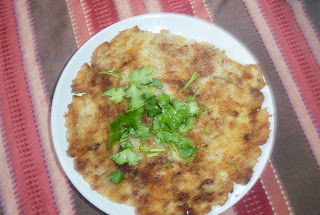Ingredients:
For the cake:
5 cups glutinous rice, washed and soaked overnight
Banana leaves, washed and dried
For the Filling:
1 recipe for seitan (mock meat substitutes for pork) optional
2 1/2 cups dried slit mung beans, washed and soaked overnight
2 shallots, thinly sliced
2 leeks, use white part, thinly sliced
2 tsp salt
3 tsp black pepper
1 tsp sugar
1 tbs mushroom seasoning powder (bot nem nam)
2 tsp good soy sauce
1/2 cup vegetable or peanut oil
Directions:
For the seitan meat:
Slice seitan into a 1/8 inch thick by 6 inch-long piece. Mix 2 tbs soy sauce, 1 tsp sugar, 1 tsp salt and 1 tbs chopped shallots. Add meat and marinate overnight.
For the mung beans:
In a large steamer over high heat, steam mung beans for 15 to 20 minutes or until beans get soft.
Let beans cool off and process in the food processor until become fine.
Heat 1/4 cup of oil in nonstick pan. Add shallots and leeks and cook until fragrant (about 3 minutes).
Add mung beans. Season with soy sauce, sugar, salt, black pepper and mushroom seasoning. Stir this mixture together.
Add the rest of the oil and remove from heat. Let it cool off and form the beans mixture into a ball (about 8 portions), each portion about 1/2 cup
For the rice:
Add 2 tsp of salt into rice.
To assemble the rice cake (plastic wrap, foil, kitchen twine are needed):
I use a wooden 4" x 4" x 2" mold.
Cut the banana leaves larger size than the mode (about 10" x 6") . Each cake will need 4 banana leaves.
Place a 10" x 10" piece of plastic wrap on the countertop. Place the mold on top of the plastic wrap.
Lay a banana leaf on top of the wooden mold. Neatly tuck leaf into all four corners.
Add ½ cup of sweet rice at the bottom.
On top of the rice, add 1/4 cup of mung beans and a few pieces of seiten meat on top of the mung beans.
Then add another 1/4 cup of the mung beans to cover the meat.
Fill to top with another ½ cup of rice; Spread the rice to cover entire surface of the cake.
Seal the cake with hanging banana leaves.
Carefully remove the mold. Wrap the rice cake with the plastic wrap. Cut a piece of foil (about 10" x 10"). Place cake in the center of the foil and seal the cake with foil (this will assure the water will not find a way to get into the rice while cooking).
Tie cake with kitchen twine.
Put the rice cakes in a 10 qt. pot. Fill with hot water.
Place some heavy objects, such as a stone, on top of the cake to keep cakes from floating while cooking. This will make the cakes cook evenly because the cakes should always be submerged in the hot water. Cover pot and bake in a preheated oven set to 375° for 10 hours. Check every hour to check the water level and fill with hot water, if needed. Baking the rice cakes in the oven is a new technique that I learned instead of the traditional way of cooking on the stove top. The oven heat will be distributed evenly during the cooking time. The water will not evaporate much, so cooks can relax at this point.
After the cooking time is over, remove the rice cakes from the pot. Wash cakes with cold water to remove some starch built up around the cake during cooking (this will make the rice cakes cleaner and keep fresh longer).
Place rice cakes on a tray. Place another tray on top of the rice cakes. Place some heavy object on top of the tray to squeeze out any liquid in the cakes. Leave cakes at this point for a few hours. Then refrigerate.
The cakes can be kept for several weeks and reheated in a microwave or by reboiling. I freeze my cakes for several months.
To serve, cut each cake through the center into four squares and eat with Vietnamese vegetable pickle (dua mon). Another way to enjoy these cakes is to fry them in a nonstick pan with very little oil to make a pancake. Either way this fantastic cake is delicious.


























No comments:
Post a Comment